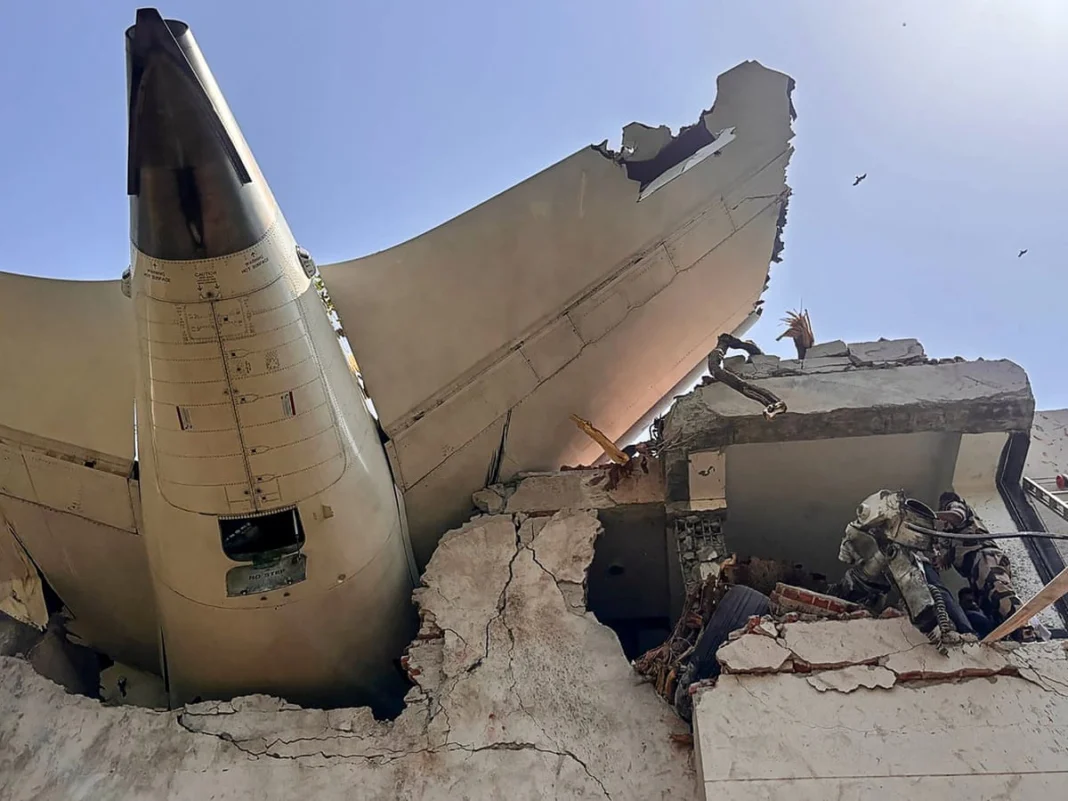Boeing faces its most serious safety crisis in years after the deadly crash of Air India Flight 171 killed 241 of the 242 people on board. The disaster with a Boeing 787 Dreamliner shattered its perfect safety record since its 2011 introduction. The aircraft crashed into a densely populated area and struck a medical college hostel right after takeoff from Ahmedabad.
Boeing’s troubles have intensified even though it celebrated carrying its billionth passenger recently. The company now faces renewed scrutiny, as with the previous Boeing 737 MAX crashes. Boeing’s share price dropped nearly 5% after the disaster, reflecting the company’s mounting challenges. This financial setback hits harder because Boeing’s stock had already been under pressure from recent settlements. The aviation giant agreed to pay over $1.1 billion in fines for past incidents and barely avoided criminal prosecution last month. Kelly Ortberg, Boeing’s newly appointed CEO who came back from retirement, must now tackle safety concerns while managing the worst aviation disaster in a decade.
Air India Flight 171 Crashes in Ahmedabad
Image Source: The Guardian
Air India Flight 171 crashed into a densely populated area in Ahmedabad on June 12, 2025. This tragic incident became the first fatal crash with a Boeing 787-8 Dreamliner since the aircraft’s introduction to service in 2011.
Plane crashes into residential area after takeoff
The Boeing aircraft left Sardar Vallabhbhai Patel International Airport at 1:38 pm local time. The plane crashed within seconds after takeoff. Flightradar24, a flight tracking website, received its last signal from the aircraft at an altitude of just 625 feet. The flight lasted about five minutes before crashing at 1:38 pm. Air traffic control received a “Mayday” distress call right before losing contact.
Witnesses captured video footage of the aircraft as it struggled to gain altitude. The plane crashed into Meghani Nagar, a residential area next to the airport. A massive fireball lit up the city’s skyline after the impact. The aircraft hit BJ Medical College’s hostel, specifically the dining area where students were having lunch.
241 confirmed dead, one survivor identified
The crash claimed 241 lives out of 242 people on board. The passenger list included 169 Indian nationals, 53 British nationals, seven Portuguese nationals, and one Canadian national. The crash also killed five medical students in the hostel’s dining facility and injured about 50 others.
The crash had one miraculous survivor. Vishwash Kumar Ramesh, a British citizen of Indian origin, made it out alive. He sat in seat 11A next to an emergency exit. Doctors at Ahmedabad Civil Hospital reported that despite multiple injuries and disorientation, Ramesh’s condition remained stable. People saw him walking away from the crash site wearing a bloodstained shirt.
Emergency response and rescue efforts underway
First responders rushed to the scene as fire brigades and medical teams sprang into action. Several ambulances arrived quickly while police cleared nearby traffic. The Indian Army sent 130 personnel, including medical staff, to help civil authorities clear debris and treat survivors.
Rescue teams brought sniffer dogs to search through the wreckage. Gujarat’s Chief Minister directed officials to “arrange a green corridor to transport the injured passengers for treatment”. The Ahmedabad airport stopped all flight operations temporarily. Air India’s parent company, Tata Group, set up an emergency center with support teams to help families get information about their loved ones.
Boeing Faces Renewed Questions Over Safety Standards
Image Source: KTVZ
Boeing faces intense scrutiny over its manufacturing processes and safety standards after the catastrophic Air India disaster. The aerospace giant deals with mounting questions about quality control across its aircraft lineup as industry confidence remains shaken by previous incidents.
First fatal crash involving Boeing 787 Dreamliner
The Ahmedabad crash marks a devastating setback for the 787 program that had maintained an exemplary safety record. The Dreamliner carried over 1 billion passengers without any fatal accidents before this incident. The model experienced manufacturing problems with its lightweight carbon-fiber composite structure – a breakthrough that made the jet lighter and more fuel efficient. A Boeing 787 Dreamliner suffered a sudden drop in altitude over the Tasman Sea last year, which injured 50 passengers.
Comparison with Boeing 737 MAX crash history
Boeing’s 737 MAX crisis haunts the company as the Air India tragedy unfolds. Two fatal crashes killed 346 people in Indonesia (Lion Air) and Ethiopia (Ethiopian Airlines) during 2018 and 2019. These crashes were linked to a software issue (MCAS) that forced the planes into nosedives. All 737 MAX aircraft remained grounded worldwide for 20 months. A 737 MAX 9 suffered an uncontrolled decompression in January 2024 when an unsecured door plug blew out at 15,000ft above Portland, Oregon.
Whistleblower claims and internal safety concerns
Boeing’s safety practices came under fire from many whistleblowers. John Barnett, Boeing’s quality manager for over 30 years, claimed that workers under pressure fitted sub-standard parts to aircraft. Engineer Sam Salehpour warned about premature failure risks and asked Boeing to “ground every 787 Dreamliner jet worldwide”. Richard Cuevas, a mechanic at Boeing’s contractor, reported seeing improperly drilled holes in 787 planes.
Boeing’s past settlements and legal challenges
Boeing reached an agreement with the US Department of Justice last month to avoid criminal prosecution. The company admitted to “conspiracy to obstruct and impede” the Federal Aviation Administration’s investigation. Boeing paid AED 1,788 million in fines and must establish a safety compliance program with independent monitoring as ordered in July 2024.
Air India’s Rebranding Efforts Suffer Major Setback
Image Source: The Economic Times
The Ahmedabad crash has dealt a crushing blow to Air India’s ambitious comeback plans. This tragic event has stopped what seemed like a promising new chapter under fresh ownership. The airline must now rebuild its image after the first deadly crash of a Boeing 787 Dreamliner.
Tata Group’s acquisition and modernization plans
Tata Group bought back Air India from the government for Rs 18,000 crore in January 2022. This landmark deal brought the airline back to its original founders after 69 years of government control. Chairman N. Chandrasekaran quickly launched a five-year plan to restore Air India’s status as a world-class carrier.
The bold “Vihaan.AI” strategy aimed to enhance customer experience, make operations more reliable, and improve financial results. Tata made a strategic decision to combine its aviation businesses. Air India merged with Vistara to create India’s biggest international carrier and the second-largest domestic airline.
Recent aircraft orders including Boeing 737 and 787
Air India’s comeback centered on a record-breaking fleet expansion announced in February 2023. The airline ordered 470 aircraft worth about $70 billion at list prices – making it the biggest commercial aviation deal ever. This massive purchase included 190 Boeing 737 MAX aircraft, 20 Boeing 787 Dreamliners, and 10 Boeing 777X widebody jets.
The crashed aircraft was a Boeing 787-8 Dreamliner from Air India’s current fleet of 27 Dreamliners that started flying in 2012. These fuel-efficient widebody jets were crucial to the airline’s plans to grow its profitable long-haul routes to Europe and North America.
Impact on Air India’s international reputation
This disaster could erase three years of careful work to rebuild the brand. Air India had made great progress in improving punctuality, customer service, and updating its fleet. Now the airline faces intense public scrutiny and possible passenger concerns.
Industry experts say the crash will make it harder to complete the planned merger with Vistara by year-end. The airline might also need to pause its international expansion plans while dealing with this crisis. Questions about Air India’s safety monitoring and maintenance have emerged, even though investigators will likely focus on Boeing’s manufacturing standards.
Crash Triggers Legal, Financial, and Regulatory Fallout
Image Source: GuruFocus
The Dreamliner disaster has sent shockwaves through financial markets, corporate boardrooms, and regulatory bodies. This tragic incident has freed a domino effect of consequences for Boeing beyond the devastating human toll.
Boeing stock drops nearly 5% post-crash
Boeing’s market value took a nosedive just hours after the Air India crash. The company’s shares ended at AED 747.61, a sharp 5% drop from AED 785.94 the previous day. The stock had dropped more than 8% in pre-market trading. IG Group analyst Chris Beauchamp called it a “knee-jerk” reaction that showed “revised fears of the problems that plagued Boeing aircraft and Boeing itself in recent years”. The financial hit comes at a tough time for Boeing, despite its 20% stock rise this year after fixing issues from earlier crises.
CEO Ortberg cancels Paris Air Show appearance
Boeing’s top executives made a quick change of plans. CEO Kelly Ortberg and Commercial Airplanes chief Stephanie Pope pulled out of the Paris Air Show scheduled for June 16-20. Ortberg told staff they needed to “be with our team and focus on our customer and the investigation”. The mood at the aviation industry’s biggest trade show has turned grim. Several companies might push their order announcements to later this year to respect the crash victims.
Global aviation regulators launch investigations
A team of NTSB investigators has headed to India. The FAA has joined forces with Boeing and engine maker GE Aerospace in the investigation. Transportation Secretary Sean Duffy made it clear: “The U.S. government will not hesitate to implement any safety recommendations that may arise. We will follow the facts and put safety first”.
Potential lawsuits and compensation claims
This crash could become India’s costliest aviation claim, with possible payouts between AED 774.78 million and AED 1028.14 million. The Montreal Convention of 1999 entitles each victim’s family to about AED 3.67 million (Rs 1.47 crore). Tata Group has stepped up with a Rs 1 crore compensation offer for each victim’s family. Air India will get AED 275-280 million for the lost aircraft. AIG, Axa and Allianz lead a group of reinsurers covering almost 95% of Air India’s policy.
The Road Ahead: Challenges and Consequences
The Air India Flight 171 disaster marks a defining moment for Boeing and the commercial aviation industry. The Boeing 787 Dreamliner’s perfect safety record now carries a tragic mark, leaving 241 families in grief and many questions without answers. Investigators now face the most important task to determine if manufacturing defects, maintenance issues, pilot error, or other factors caused this catastrophe.
Boeing faces a critical turning point. The company must guide itself through this crisis while dealing with earlier 737 MAX incidents. Their financial outlook grows shakier as share prices drop and investors lose confidence. The crisis hits at the worst possible time – right after Boeing’s settlement with the Department of Justice and during leadership changes under CEO Kelly Ortberg.
The Tata Group’s arranged transformation strategy for Air India now faces major setbacks. The airline struggles to handle the immediate crisis while pushing forward with long-term goals like fleet modernization and better service.
Global regulatory bodies will tighten their oversight of Boeing’s entire manufacturing system. The FAA, NTSB, and international authorities must join forces to keep passenger safety first. The crash also fuels ongoing debates about oversight effectiveness and corporate responsibility in aviation.
Money problems will surface for months or even years. Insurance claims, victim payments, and possible lawsuits are just the start of a complex financial fallout. Yet these costs mean little compared to the human toll – hundreds of lives cut short and countless others changed forever.
The aviation industry has bounced back from disasters before. This incident reminds us that safety watchfulness needs constant attention, whatever past records show. Though one passenger survived against all odds, this tragedy ended up as a devastating failure of life-protection systems – a failure that demands deep investigation and real change.



